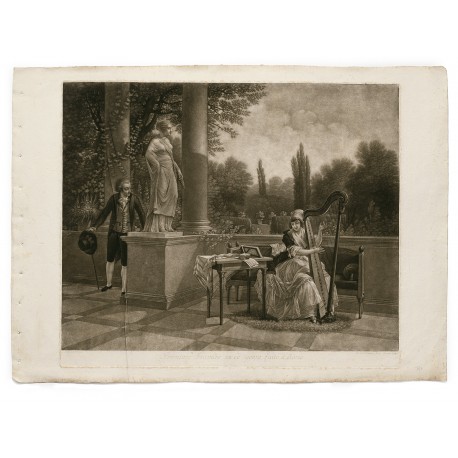 View larger
View larger
Scena di vita romana
- Subjects
- Book illustration - Reproductive printmaking - Sablet (Jacques), 1749-1803
- Prints - Artists, Italian - Cunego (Domenico), 1727-1803
- Authors/Creators
- Sablet, Jacques, 1749-1803
- Artists/Illustrators
- Cunego, Domenico, 1727-1803
- Sablet, Jacques, 1749-1803
- Printers/Publishers
- Montagnani, Pietro Paolo, active 1790?-1806?
Sablet, Jacques
Morges (Vaud) 1749 – 1803 Paris
Scena di vita romana.
Rome, [Pietro Paolo Montagnani?], 1790
Mezzotint print (480 × 575 mm platemark, 535 × 740 mm sheet), with legends beneath (left to right) J Sablet pinx | Premiere Gravure en ce genre faite a Rome | Dom.cus Cunego fecit Romae 1790.
paper watermark P Miliani (edge of sheet)
provenance Christie’s, ‘Valuable manuscripts and printed books’, London, 24 November 1993, lot 77 (part lot)
Printer’s crease, light foxing at edges of plate mark, and along sheet edges.
A mezzotint reproduction of Sablet’s early conversation piece Scène de la vie romaine ou La Joueuse de harpe (oil on canvas, 63 × 75 cm), painted in Rome circa 1787–1789, and now in the Musée des Beaux-Arts, Lausanne (Inv. 742, Dépôt de la Fondation Gottfried Keller; link).1 Sablet had received a grant from the States of Bern allowing him to study in Italy and in 1778 won first prize for a history painting in a competition at the Accademia di Belle Arti di Parma. Soon afterward he abandoned history painting for genre scenes, and developed a personal version of the English conversation piece.
The printmaker Domenico Cunego (1724–1803) was born in Verona and arrived in Rome about 1760, where he worked in collaboration with Robert Adam, Gavin Hamilton, Giovanni Volpato, among others. In 1785 Cunego travelled to Berlin, where for four years he managed the copperplate printing works (Königliche Preußische Hofkupferstichoffizin) set up by the businessman Johann Mark Pascal.2 There he experimented with engraving in the maniera nera (mezzotint), which on his return to Rome became his favourite mode of expression.
In a conspicuous legend on this print, Cunego identifies it as the ‘Premiere Gravure en ce genre faite a Rome’.3 Also in 1790 Cunego engraved a ‘Testa di evangelista’ after Giacinto Brandi, designating it the ‘Deuxieme gravure faite en ce genre à Rome’;4 both prints probably were sold by Pietro Paolo Montagnani, from his shop beside S. Maria degli Agonizzanti, in the Piazza di Pasquino.5
A conversation piece by Sablet engraved in mezzotint by Domenico Cunego, the ‘premiere gravure en ce genre faite a Rome’. Reduced from 480 × 575 mm (platemark)
1. Anne van de Sandt, Les frères Sablet (1775–1815), peintures, dessins, gravures, catalogue of an exhibition, Nantes, Lausanne, Rome (Rome 1985), pp.57–58; Il teatro e la festa. Lo Spettacolo a Roma tra Papato e Rivoluzione, catalogue of an exhibition, Museo Napoleonico, Rome, 13 June-30 September 1989 (Rome 1989), no.2.3.1a (painting reproduced p.93); Anne van de Sandt, Les frères Jacques et François Sablet : collections du Musée cantonal des Beaux-arts de Lausanne, catalogue of an exhibition, Musée cantonal des Beaux-Arts, Lausanne, 5 February-26 April 2015; Les Cahiers du Musée des Beaux-Arts de Lausanne, 19 (Lausanne 2015), no. 9.
2. Karl Heinrich von Heinecken, Dictionnaire des artistes, dont nous avons des estampes (Leipzig 1790), iv, p.452.
3. ‘Belle Arti’ in Annali di Roma. Opera periodica del Sig. Ab. Michele Mallio 2 (July–December 1790), pp.46–48: ‘Il Sig. Domenico Cunego dopo aver mostrato la sua perizia, ed i suoi talenti col suo franco Bulino, ha voluto mostrarli ancora in questo diverso modo d’incidere, e primiero ne presenti giorni ha reso publico in Roma il primo Esemplare. Questo è la copia d’un quadro del celebre Sablet, che rappresenta da un canto una Donna seduta in atto di suonar l’Arpa, mentre ha dall’altro un giovane, che la riguarda quasi furtivamente, e stassi tutto fiso, ed intento ad udire 1’arpeggiatura soave. Questa maniera eseguita da una mano maestra può far molto effetto, e non è di spregevole. Egli è vero, che non v’ ha paragone alcuno fra lei, ed il Bolino, e che dove si ammirano tante opere eccellenti di questo, non può l’altra non rimanere che molto al di sotto. Non è però, che essa non debba apprezzarsi, e che non richieda particolarmente una somma franchezza, e maestria di disegno, ed oltre a ciò è lodevol cosa 1’ aver arrichito una provincia d’un genere d’incisione, che non aveva. Quindi è, che il Sig. Cunego sarà sempre degno delle lodi, e della gratitudine dell’Italia, e di Roma.’
4. Dizionario biografico degli italiani, xxxi (Rome 1985), p.357.
5. Gazzetta universale, o sieno notizie istorice, politiche, di scienze, arti, agricoltura, ec, volume 17, no. 76 (21 September 1790), p.608: ‘Il Sig. Domenico Cunego celebre incisore in rame dopo di avere acquistata nel suo viaggio espressamente fatto nella Germania, e nominatamente a Berlino, la perizia d’incidere i rami in nero, che volgarmente dicesi sfumato, ha introdotta in questa Dominante una tal nuova forma d’incisione, come si pratica con ottima riescita ed applauso universale nella Germania, e nell’Inghilterra. Il valente Professore ha data intanto alla luce in sì fatta maniera una veduta campestre d’ottimo gusto, e sta’ attualmente perfezionando altro rame rappresentante la Scuola di Atene dipinta già nel Vaticano dall’immortal Raffaello. La prima trovasi vendibile presso il Sig. Montagnani Mercante di stampe dirimpetto alla Chiesa degli Agonizzanti.’ Cf. Giovanni Sforza, ‘Episodi della storia di Roma nel secolo xviii’ in Archivio storico italiano, fourth series, 20 (1887), p.438.



